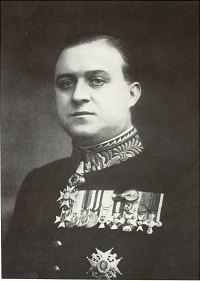Guy Francis Laking: Difference between revisions
No edit summary |
|||
| (One intermediate revision by the same user not shown) | |||
| Line 7: | Line 7: | ||
==Family== |
==Family== |
||
He was the son of [[Edward VII|King Edward VII's]] Physician in Ordinary [[Francis Laking|Sir Francis Laking]]. He married Beatrice Ida Barker (September 25, 1873 - November 23, 1923), and they had two children, Joan (*1900) and Sir Guy Francis William Laking, 3rd Baronet (January 3, 1904 - August 4, 1930), whose photographs, taken in 1920 and 1921 at [[Alexander Bassano|Bassano Ltd]], are in the collection of the [[National Portrait Gallery (United Kingdom)|National Portrait Gallery]].<ref>[http://www.npg.org.uk/live/search/person.asp?LinkID=mp61203 Sir Guy Francis William Laking, 3rd Bt (1904-1930), Son of Sir Guy Francis Laking, 2nd Bt<!-- bot-generated title -->] at www.npg.org.uk</ref> On the death of the 3rd baronet, the baronetcy became extinct. |
He was the son of [[Edward VII|King Edward VII's]] Physician in Ordinary [[Francis Laking|Sir Francis Laking]]. He married Beatrice Ida Barker (September 25, 1873 - November 23, 1923), and they had two children, Joan (*1900) and Sir Guy Francis William Laking, 3rd Baronet (January 3, 1904 - August 4, 1930), whose photographs, taken in 1920 and 1921 at [[Alexander Bassano|Bassano Ltd]], are in the collection of the [[National Portrait Gallery (United Kingdom)|National Portrait Gallery]].<ref>[http://www.npg.org.uk/live/search/person.asp?LinkID=mp61203 Sir Guy Francis William Laking, 3rd Bt (1904-1930), Son of Sir Guy Francis Laking, 2nd Bt<!-- bot-generated title -->] at www.npg.org.uk</ref> On the death of the 3rd baronet, the baronetcy became extinct. |
||
==Recent Controversy== |
|||
In 2004, [[Norway|Norwegian]] biographer [[Tor Bomann-Larsen]] put forward the hypothesis that [[Olav V of Norway|King Olav V of Norway]] was not the biological son of [[Haakon VII of Norway|King Haakon VII]], but his mother, [[Maud of Wales|Queen Maud]], had been, in 1902 in [[London]], artificially inseminated by [[Francis Laking|Sir Francis Laking]]. |
|||
==Publications== |
==Publications== |
||
Revision as of 14:42, 1 December 2008

Sir Guy Francis Laking, 2nd Baronet (October 21, 1875 - November 22, 1919 London) was an English art historian and the first keeper of the London Museum from before its opening until his death.
Life
He was educated at Westminster School. He was interested in armour from an early age, as shows his essay The Sword of Joan of Arc, written when 10 years old. In 1891 he met the Baron de Cosson, then considered the foremost expert on arms and armour, an acquaintance that was influential to his career. Later he joined Christie's as an art advisor; his first work was the sales catalogue of the Zschille collection, sold in January 1897. He then compiled catalogues for the Gurney, Spiller, Breadalbane, Kennedy and North collections of arms and armour. In 1900 he was invited by the Governor of Malta, Lord Grenfell, to catalogue the antiquities there, the result was the book The Armoury of The Knights of St. John of Jerusalem. In 1902 King Edward VII created the post of Keeper of the King's Armoury at Windsor for him. Besides, he was Inspector of the Armoury at the Wallace Collection, and in 1911 became the first Keeper of the London Museum, where he was tasked with acquiring, cataloguing and arranging the collection. He lived in London, on Avenue Road, in his house Meyrick Lodge named after Samuel Meyrick, the founder of English armour studies. He was a Vice President of the Meyrick Society, founded by collectors and historians of arms and armour. He died from a heart attack.
Family
He was the son of King Edward VII's Physician in Ordinary Sir Francis Laking. He married Beatrice Ida Barker (September 25, 1873 - November 23, 1923), and they had two children, Joan (*1900) and Sir Guy Francis William Laking, 3rd Baronet (January 3, 1904 - August 4, 1930), whose photographs, taken in 1920 and 1921 at Bassano Ltd, are in the collection of the National Portrait Gallery.[1] On the death of the 3rd baronet, the baronetcy became extinct.
Publications
- The Sword of Joan of Arc (1885)
- The Armoury of The Knights of St. John of Jerusalem (1902)
- The Armoury of Windsor Castle: European Section (1904)
- The Furniture of Windsor Castle (1905)
- The Sèvres Porcelain of Buckingham Palace (1907)
- Catalogue of the European Armour and Arms in the Wallace Collection at Hertford House (1910)
- A Record of European Armour and Arms through Seven Centuries (1919)
Notes
External links
- [1] Biography
